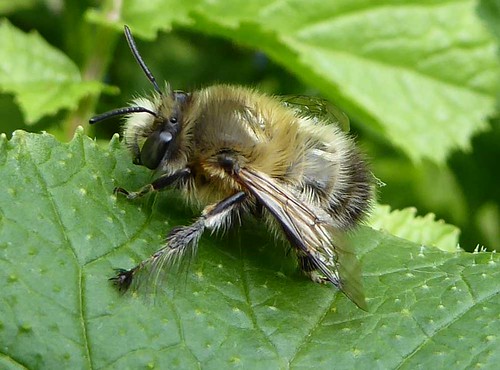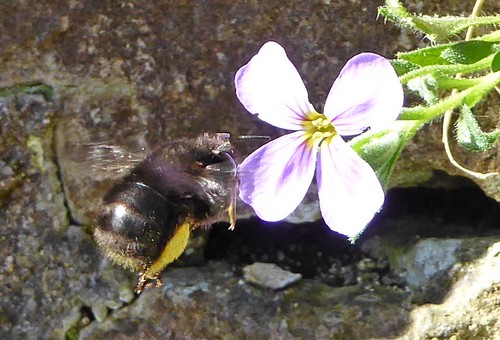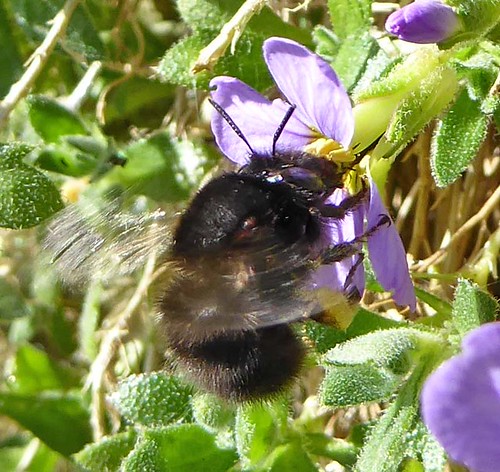This year I promised myself I would try to get to know one our early solitary bees. I’d seen them in previous years but I knew there was more to learn so, from early March, I started looking carefully at the flowers in the local community garden, the Leechwell Garden. It was a bit frustrating as spring didn’t seem to know how to get started, rather like a sulky teenager on their way to school. The slow season had its effect on the flowers; there were plenty of primroses and dandelions and some rosemary but the early lungwort, a favourite of my chosen bee, was a bit short on blooms. It didn’t help my mood when a friend phoned to say she had seen one of the bees in a garden in Cornwall.
………………………….

I had to wait another week after the phone call but eventually I was rewarded. Around lunchtime one sunny but cool March day, I heard a harsh buzz from the direction of some rosemary growing against one of the old stone walls. When I investigated, I saw one of my chosen bees working the disorderly blue-grey flowers, but he saw me coming and promptly flew away. Nevertheless, the spell had been broken and I began to see one or more of the bees each time I visited.
Rosemary and lungwort were their favourites and they moved deftly from bloom to bloom in search of nectar, long tongue often extended in readiness. Pausing to feed each time for a second or so, they emitted an urgent buzz as they moved, sometimes hovering briefly as if to take stock, their wings a pale blur in the sunshine. Despite the rapid staccato movements, I could see that they were roughly the size of a small bumblebee and covered in pale brown hair. Their distinctive, pale facial markings also stood out, reminding me of masked revellers at the Venice carnival.
These were male Hairy-footed Flower Bees (Anthophora plumipes), some of the earliest solitary bees to appear in the UK as winter stumbles slowly away. In this part of Devon, my first sighting was in March, around the time of the Spring Solstice, their presence providing a rather wonderful indicator of the new season. They are partial to lungwort flowers but feed from a wide variety of others. This year I have seen them feeding from banks of rosemary in a seafront garden, from aubretia cascading down an ancient wall and from three cornered leek growing in a long border near the sea. They forage at lower temperatures than many other bees making them important early season pollinators. In a rural setting, they are important pollinators for broad beans.

I tried to photograph them but they were rarely still, moving very quickly, seeming to object when I got too close, hovering in the air and buzzing loudly as if to frighten me away. After some persistence I managed to get a good photo showing their hairy middle legs and feet, celebrated in their name. The photo also shows their subtly marked abdomen with its alternate pale and dark stripes.
…………………………

By early April, the lungwort was flowering well and the pale brown males were regular visitors to these trumpet-shaped flowers. They were joined by another chunky bee, this one jet-black except for two orange-tan flashes towards their rear. Easily confused with a small bumblebee and surprisingly different from the males, this was the female Hairy-footed Flower Bee. The female bees moved around the flowers as quickly and as edgily as the males, like small mobile black bullets. The splashes of colour come from thick tufts of orange/tan hairs on their back legs. These are their pollen hairs, used for collecting as they visit different flowers. A female with her yellow-loaded pollen hairs is a fine sight at this time of year.


The females were just as sensitive to my presence as the males, displaying a belligerent attitude as they hover and buzz aggressively in mid air. Occasionally they would check me out, hovering and looking, darting to right or left, hovering and looking, sometimes circling right round me. Bumblebees sometimes also take a good look, circling around me, even landing on my sleeve but this is a dialogue whereas my interaction with the Hairy-footed Flower Bee felt more confrontational.
For a few weeks, I saw a mixture of males and females feeding on flowers and it’s surprising how common they are. Occasionally they performed an aerial dance, circling around one another. Sometimes the males were more aggressive, hovering a few centimetres behind a feeding female, buzzing loudly and then pouncing, knocking the female off the flower. Given that the females have usually already mated, this behaviour is counter-productive and wastes valuable female foraging time. Perhaps the males are just hard-wired to behave in this manner as it ensures mating success.
…………………….

By the third week of April I saw mostly the jet-black females, working hard, busily collecting for their nests, visiting a wide range of flowers. It takes each female about a day to provision one cell with pollen and nectar for the developing egg. Nests tend to be in sunny vertical surfaces such as cliffs, soil banks or holes in soft walls but although there are many old walls in Totnes with loose mortar I haven’t located a nest yet. John Walters wrote a nice description of A. plumipes nests in a soft cob wall near a Devon church. The cob wall offers good nesting conditions so the bees tend to nest in aggregations even though they are solitary bees.
The few males about looked faded and discoloured and noticeably slower than earlier in the season. They play an essential role in the survival of the species but they have mated with the females and are not needed anymore.
My last sighting of these bees was on May 15th. This seemed a little early and I can’t be sure if it reflected the lifetime of the bees or the bees foraging elsewhere. We won’t see the bees again for nine or ten months and the action now switches to the nests where eggs develop in to larvae eventually producing the new bees that will emerge next spring.


Lovely post. I have seen some of the females this year busy by flowers peeking over garden walls. I wonder if I would mistake the males for carder bees.
LikeLiked by 1 person
Thanks Emily, I think the behaviour of these bees and the carder bees is quite different so you would be unlikely to confuse them, it’s the rapid darting movement of the Hairy-footed flower bee that sets it apart.
LikeLike
I am so impressed by your knowledge of bees, Philip. I can barely distinguish the differences even when I try to pay attention. My rosemary is covered in bees at this time, and you’ve now given me a reason to see what I can learn about them.
LikeLike
Thanks Debra, rosemary is an excellent flower for bees so it’s worth having a closer look – and it’s very distracting.
LikeLike
Your pictures are fantastic! There is something really special about Anthophora plumipes and I recognise that cheeky behaviour that you describe so well. I love its distinctive buzz which is so much part of springtime. I have never seen the black females but they look beautiful with the orange leggings. My males and females are both a grey colour over here. I have Cerinthe major in my garden and it is a magnet for Anthophora plumipes, I don’t know if you have room for it in your garden (I have seeds if you need them). Amelia
LikeLike
Thanks Amelia, I agree there is something really special about them. I have never seen the continental version except in your pictures. Thank you for the offer of Cerinthe seeds, that would be very good – I’ll send you an email with my address.
LikeLike